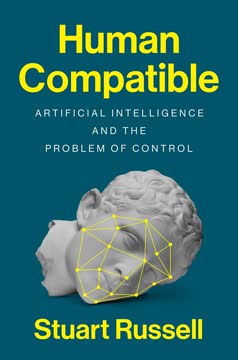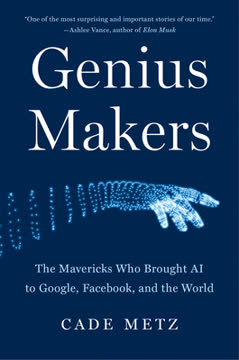Key Takeaways
1. Technological progress threatens widespread unemployment
The threat of 'technological unemployment' is now real.
Accelerating capabilities. Rapid advances in artificial intelligence and robotics are enabling machines to perform an ever-expanding range of tasks previously done by humans. This includes both manual and cognitive work across many industries.
Economic disruption. As machines become more capable, they are likely to displace large numbers of workers, potentially leading to widespread unemployment. This could fundamentally disrupt labor markets and economic structures.
Societal impact. Technological unemployment threatens not just individual livelihoods, but social stability and meaning. As work has been central to human life and society, its loss could have profound psychological and cultural effects.
2. Past anxiety about automation was often misplaced
Throughout history, there has always been enough demand for the work of human beings to avoid the emergence of large pools of permanently displaced people.
Historical precedent. Previous waves of automation, from the Industrial Revolution onward, sparked fears of mass unemployment. However, new jobs and industries consistently emerged to employ displaced workers.
Complementary effects. While machines displaced some workers, they often made others more productive. New technologies also grew the overall economic pie, creating more total demand for labor.
Changing nature of work. Rather than eliminating human work entirely, automation typically changed the types of jobs available. Workers adapted by developing new skills for emerging roles.
3. AI capabilities have advanced rapidly through pragmatic approaches
Despite the initial burst of optimism and enthusiasm, no serious progress was made in AI. When it came to the grand challenges – building a machine with a mind, one that was conscious, or that could think and reason like a human being – the defeat was emphatic.
Shift in approach. Early AI research aimed to replicate human intelligence, with little success. Modern AI has made breakthroughs by using statistical methods and vast datasets to solve specific problems.
Diverse capabilities. Today's AI systems can outperform humans at complex games, recognize speech and images, translate languages, and more. This is despite not replicating human cognitive processes.
Ongoing expansion. AI capabilities continue to grow rapidly across domains like healthcare, finance, transportation, and creative work. The full potential remains unclear but significant.
4. Task encroachment will gradually reduce human employment
As time passes, that work is likely to sit beyond the reach of more and more people. And, as we move through the twenty-first century, the demand for the work of human beings is likely to wither away, gradually.
Incremental displacement. Machines are taking on more tasks over time, slowly reducing the range of activities where humans have an advantage. This is occurring across manual, cognitive, and even social domains.
Uneven impacts. Task encroachment affects different industries, regions, and skill levels at varying rates. Some areas face rapid automation while others change more slowly.
- High-skill knowledge work is increasingly affected
- Many low-skill service jobs remain challenging to automate
- Middle-skill jobs face significant pressure
Long-term trend. While not an overnight shift, the gradual nature of task encroachment makes it a persistent force reshaping employment over decades.
5. Frictional technological unemployment is already emerging
Today is not the first time that automation anxiety has spread, nor did it first appear in the 1930s with Keynes. In fact, ever since modern economic growth began, centuries ago, people have periodically suffered from bouts of intense panic about being replaced by machines.
Skills mismatch. Many workers lack the skills for available jobs, especially as middle-skill roles decline and high-skill jobs grow. Retraining is often challenging.
Identity mismatch. Some workers are unwilling to take available jobs that don't match their self-image or desired lifestyle. This particularly affects displaced manufacturing workers.
Place mismatch. Job opportunities are often concentrated in different geographic areas than where unemployed workers live. Relocation can be difficult.
- Financial constraints limit mobility
- Family and community ties keep people in place
- Housing costs in high-opportunity areas create barriers
6. Structural technological unemployment looms in the long-term
As machines keep becoming increasingly capable, many human beings will eventually be driven out of work.
Weakening complementary effects. While automation has historically complemented human labor in many ways, these positive effects may diminish as machines become more broadly capable.
Shrinking human advantage. The range of tasks where humans clearly outperform machines is likely to keep narrowing, leaving fewer roles where human workers are essential.
Economic shifts. As the relative productivity and cost-effectiveness of machines improve, economic incentives will increasingly favor automation over human employment in many areas.
- Capital owners benefit more than workers
- Labor's share of economic output may continue to decline
- New job creation may not keep pace with displacement
7. Rising inequality foreshadows technological unemployment
Today, we talk about 'horsepower', harking back to a time when the pulling power of a draft horse was a measure that mattered, future generations may come to use the term 'manpower' as a similar kind of throwback, a relic of a time when human beings considered themselves so economically important that they crowned themselves as a unit of measurement.
Income concentration. Wealth and income are increasingly concentrated among top earners and capital owners, while wages stagnate for many workers.
Labor market polarization. The job market is splitting between high-skill, high-wage jobs and low-skill, low-wage jobs, with a hollowing out of the middle class.
Capital vs. labor. The share of economic output going to workers (wages) is declining relative to the share going to capital owners (profits, rents, etc.).
- Top 1% income share has roughly doubled in many countries since 1980
- Labor's share of GDP has fallen significantly in most developed economies
- Wealth inequality is even more extreme than income inequality
8. Education alone cannot solve technological unemployment
More education was needed.
Limits of retraining. While education and retraining are valuable, they face limits in preparing all workers for an automated economy. Some lack the capability or resources for high-skill roles.
Changing skill demands. The skills needed in the economy are evolving rapidly, making it difficult for education systems to keep pace and provide relevant training.
Insufficient job creation. Even with improved education, there may simply not be enough jobs for all workers as automation progresses. Education can't solve a fundamental lack of demand for human labor.
- Automation is affecting even high-skill, well-educated workers
- The pace of technological change outstrips many workers' ability to adapt
- Social and economic barriers limit access to effective retraining for many
9. A "Big State" will be needed to address unemployment and inequality
If we are to find a way to narrow the inequalities by a less cataclysmic route than in the past, it is clear that tinkering and tweaking, as the state has tried before, will not be enough. The only way to deal with the looming disparities is to attack them aggressively and directly.
Expanded redistribution. Governments will likely need to significantly increase taxes on high earners and capital owners to fund expanded social programs and income supports.
Universal basic income. Some form of guaranteed income may be necessary to ensure basic living standards as employment declines. This could be unconditional or tied to social contributions.
Public employment. The state may need to become an employer of last resort, creating public service jobs to employ those displaced by automation.
- Higher taxes on capital, high incomes, and wealth
- Expanded social safety net and public services
- Potential job guarantee or work-sharing programs
10. Big Tech's growing power requires new regulatory approaches
In the twenty-first century, we will have to build a new age of security, one that no longer relies on paid work for its foundations. And we have to begin this task today.
Economic concentration. A small number of technology companies are gaining enormous market power and financial resources. This raises concerns about competition and innovation.
Social and political influence. Big Tech firms increasingly shape public discourse, access to information, and even democratic processes. This creates new challenges for governance and accountability.
Data and privacy issues. The vast data collection and analysis capabilities of tech giants raise significant privacy concerns and questions about data rights.
- New antitrust approaches may be needed for the digital economy
- Regulation of social media and content platforms is evolving
- Data protection and algorithmic accountability are key policy areas
11. Finding meaning beyond work will be a key challenge
We can speculate about what those required activities will be. Some communities, populated by people like Keynes and Russell, might be satisfied if those without work spend their time in pursuit of artistic and cultural ends: reading, writing, composing beautiful music, thinking deep thoughts.
Redefining purpose. As work becomes less central to many people's lives, individuals and societies will need to find new sources of meaning, identity, and social connection.
Cultural shift. Moving away from the work-centric culture that has dominated since the Industrial Revolution will require significant psychological and social adaptation.
New forms of contribution. Non-economic activities like volunteering, caregiving, civic engagement, and creative pursuits may gain greater social recognition and support.
- Education may need to focus more on life skills and personal development
- Community organizations could play a larger role in providing structure and purpose
- Universal basic income might be tied to social contributions rather than traditional work
Last updated:
FAQ
What's A World Without Work about?
- Explores technological unemployment: The book examines how advancements in technology and automation are leading to a future with significantly less work available for humans.
- Historical context provided: Daniel Susskind uses past instances of automation anxiety to illustrate how fears of job loss have historically been misplaced, but warns that current technological advancements may lead to real unemployment.
- Focus on societal response: Susskind emphasizes the need for society to rethink how we share economic prosperity in a world where traditional employment may not be sufficient for everyone.
Why should I read A World Without Work?
- Timely and relevant topic: As automation and AI continue to evolve, understanding their implications on employment is crucial for everyone, from policymakers to workers.
- In-depth analysis: The book provides a thorough examination of the historical, economic, and social factors surrounding work and technology, making it a comprehensive resource.
- Proposes solutions: Susskind not only identifies the problems but also suggests potential responses, including the role of a "Big State" in addressing inequality and unemployment.
What are the key takeaways of A World Without Work?
- Technological unemployment is real: Susskind argues that unlike past fears, the threat of technological unemployment is imminent due to advancements in AI and automation.
- Shift in demand for work: The book highlights that as machines take over more tasks, the demand for human labor will diminish, leading to a potential future with insufficient work.
- Need for new economic models: Susskind advocates for rethinking how society distributes wealth and prosperity, suggesting that traditional labor markets may no longer suffice.
What is the "superiority assumption" in A World Without Work?
- Definition of the assumption: The superiority assumption is the belief that human beings will always be better suited to perform tasks than machines, which has historically been true but may not hold in the future.
- Implications for the future: As machines become more capable, this assumption may lead to a significant decline in the demand for human labor, as machines will increasingly take over tasks once thought to require human skills.
- Challenge to traditional views: Susskind argues that this assumption needs to be reevaluated, as it could result in a world where machines dominate the labor market.
What is "task encroachment" in the context of A World Without Work?
- Definition of task encroachment: Task encroachment refers to the gradual process by which machines take over tasks that were traditionally performed by humans, leading to a shrinking set of activities for people.
- Impact on employment: As machines encroach on more tasks, the range of jobs available to humans will diminish, potentially leading to structural technological unemployment.
- Historical examples: Susskind illustrates this concept with examples from agriculture and manufacturing, where increased automation has already reduced the number of jobs available.
What is the Conditional Basic Income (CBI) proposed in A World Without Work?
- Definition of CBI: The CBI is a form of income support that provides regular payments to individuals, but with conditions attached. Recipients are required to contribute to their communities in meaningful ways.
- Encouraging community contribution: Susskind argues that the CBI can help maintain social solidarity by ensuring that everyone contributes to the collective good, even if they are not engaged in paid work.
- Flexibility in implementation: The specifics of what contributions are required can vary by community, allowing for tailored approaches that reflect local values and needs.
What role does the Big State play in Susskind's vision in A World Without Work?
- Taxation and redistribution: The Big State is envisioned as a mechanism for taxing wealth generated by automation and redistributing it to those affected by job loss.
- Support for non-economic contributions: The Big State would facilitate the CBI, encouraging individuals to engage in community service or other meaningful activities.
- Regulation of Big Tech: Susskind argues that the Big State must regulate the growing power of technology companies to prevent abuses of political influence.
What are the implications of technological unemployment discussed in A World Without Work?
- Shift in job availability: Susskind highlights that as machines take over more tasks, the number of available jobs will decrease, leading to widespread unemployment.
- Economic and social consequences: The book discusses how technological unemployment could exacerbate existing inequalities and create social unrest.
- Need for new policies: Susskind argues that traditional labor market policies will be insufficient in addressing the challenges posed by technological unemployment.
How does Susskind address the issue of meaning in a world with less work in A World Without Work?
- Importance of purpose: Susskind argues that work has traditionally provided individuals with a sense of purpose and identity.
- Community contributions: The CBI is proposed as a way to encourage individuals to engage in community service or other meaningful activities.
- Rethinking values: Susskind suggests that society must reevaluate what is considered valuable and meaningful, moving beyond traditional economic measures.
What are the best quotes from A World Without Work and what do they mean?
- "Will there be enough work for everyone to do in the twenty-first century?": This quote encapsulates the central question of the book, highlighting the urgency of addressing the future of work in light of technological advancements.
- "The future depends on ourselves, and we do not depend on any historical necessity.": This quote emphasizes the importance of human agency in shaping the future, suggesting that while technology will advance, society has the power to influence its impact.
- "Technological unemployment is simply a more extreme version of that story.": This quote connects the historical context of economic inequality with the emerging threat of technological unemployment, underscoring the need for proactive solutions.
How does A World Without Work relate to current discussions about AI and automation?
- Relevance to ongoing debates: The book provides a framework for understanding the implications of AI and automation on employment, making it a timely contribution to current discussions.
- Historical perspective: By examining past instances of automation anxiety, Susskind contextualizes today's fears and challenges.
- Call for action: The book urges readers to consider not just the technological advancements themselves, but also the societal and economic structures that will need to adapt in response to these changes.
How does Susskind envision the future of work in A World Without Work?
- Less paid work: Susskind predicts a future where traditional paid work is significantly reduced due to automation and AI.
- New forms of contribution: He envisions a landscape where individuals engage in various non-economic activities that contribute to their communities.
- Evolving social structures: The future will necessitate a rethinking of social structures and policies to support individuals in finding meaning and purpose outside of traditional employment.
Review Summary
A World Without Work explores the impact of automation on employment, arguing that technological progress will lead to widespread job displacement. While some reviewers praise Susskind's balanced approach and thought-provoking ideas, others criticize his solutions as unrealistic. The book discusses potential responses to technological unemployment, including education reform, taxation, and a conditional basic income. Many readers found the book informative and well-researched, though some felt it lacked practical solutions. Overall, reviewers appreciated Susskind's analysis of the challenges posed by AI and automation in the future job market.
Similar Books










Download PDF
Download EPUB
.epub digital book format is ideal for reading ebooks on phones, tablets, and e-readers.





